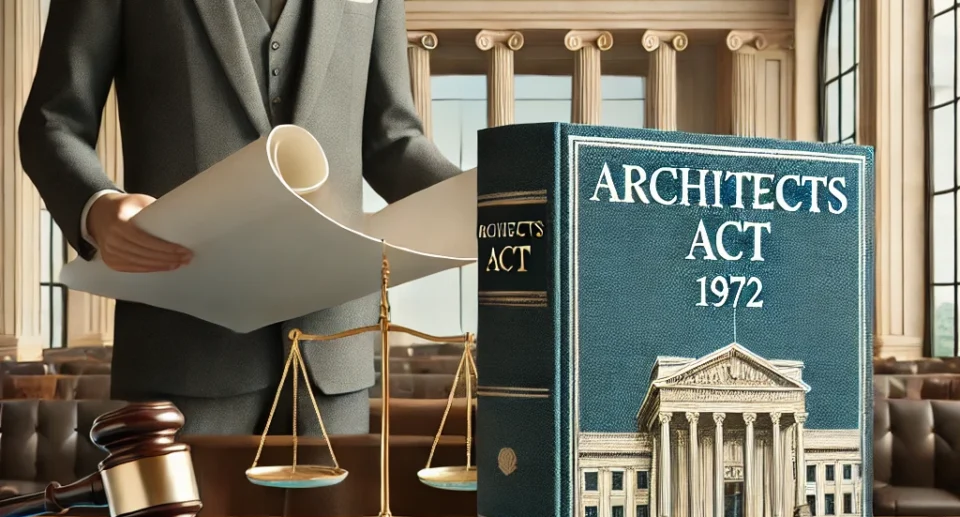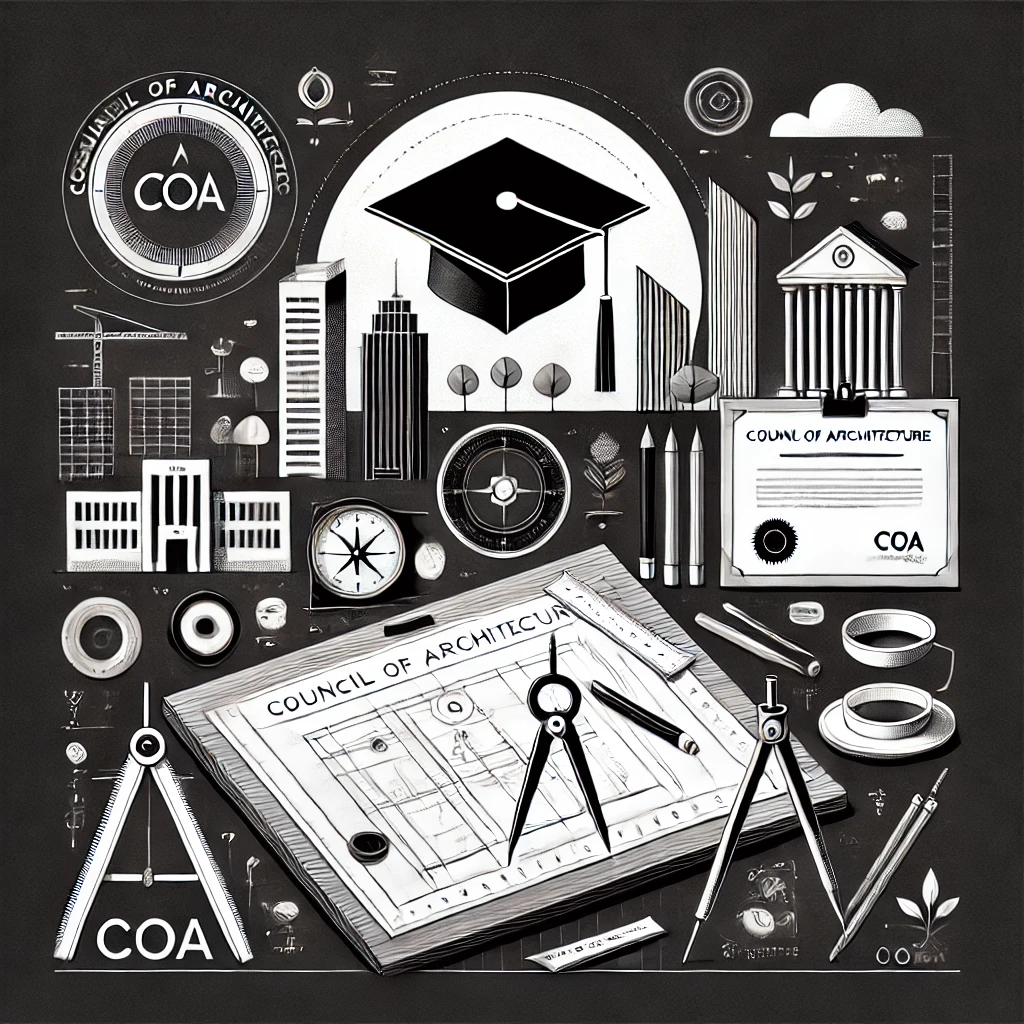The Architects Act, 1972: A Complete Guide to Regulations, Registration, and Professional Ethics

The Architects Act, 1972 – Everything You Need to Know
Introduction to the Architects Act, 1972
- Professional practice in architecture refers to the ethical, legal, and business aspects of working as an architect.
- It includes understanding professional responsibilities, contracts, fees, project management, and relationships with clients and authorities.
Table of Contents
Need for the Architects Act in India
Growth of Architecture as a Regulated Profession
Before the enactment of the Architects Act, 1972, the profession of architecture in India was largely unregulated. There was no legal framework to define who could call themselves an “architect,” leading to an influx of unqualified individuals practicing architecture without proper education or training. This created challenges such as:
- ◈ Lack of standardized education and training in architecture.
- ◈ No regulatory body to oversee professional conduct and ethics.
- ◈ Unfair competition between qualified architects and unqualified designers.
To address these issues, the Government of India introduced the Architects Act in 1972, establishing the Council of Architecture (COA) to regulate the profession, maintain a register of qualified architects, and set minimum educational and professional standards.
Role of the Indian Institute of Architects (IIA) in Advocating the Act
The Indian Institute of Architects (IIA), founded in 1917, played a key role in advocating for statutory regulations in the architectural profession. As the premier professional association for architects in India, the IIA actively lobbied for the legal recognition of architecture as a regulated profession, ensuring that only trained and qualified individuals could design and oversee buildings. Their efforts significantly contributed to the drafting and passage of the Architects Act, 1972, providing a strong foundation for the development of the profession.
Implementation of the Architects Act, 1972
The Architects Act, 1972, officially came into force on 1st September 1972. Since then, it has played a crucial role in defining architectural practice in India, setting standards for education, ethics, and professional conduct, and ensuring accountability within the industry.
Structure of the Architects Act, 1972
The Act begins with a preamble, followed by four main chapters and a schedule that lists recognized qualifications.
Preamble
An Act to provide for the registration of architects and matters connected therewith
Chapter I: Preliminary
This chapter provides an overview and foundation for the Act, covering:
- ◈ Short title, extent, and commencement of the Act.
- ◈ Definitions of key terms such as Architect, Council, Register, Recognized Qualification, etc.
Chapter II: Council of Architecture (COA)
This chapter outlines the formation, structure, and functions of the Council of Architecture (COA), the statutory body that regulates architects in India.
Establishment, Composition, and Election Process of COA
Sections 3 to 6 of the Act discuss the establishment, composition, and election process of the COA. The Council consists of members from various professional and educational backgrounds, including nominated and elected representatives from government bodies, architecture institutions, and professional organizations. The President and Vice-President (Section 4) are elected from among the members, and their tenure, election process, and provisions for vacancies are outlined in these sections.
Validity and Functioning of the Council
To ensure smooth governance, Section 7 states that the validity of proceedings of the COA, its Executive Committee, or other sub-committees will not be affected due to vacancies. Section 8 lists the disqualifications or disabilities that prevent an individual from holding office. The procedures for meetings (Section 9) and the formation of the Executive Committee and other committees (Section 10) define how the COA carries out its responsibilities.
Remuneration, Staffing, and Financial Management
The Act also regulates the financial and administrative framework of the COA. Sections 11 to 13 cover the fees and allowances of the President, Vice-President, and members, the appointment of officers and employees, and the financial management of the Council to ensure its efficient functioning.
Recognition and Regulation of Architectural Education
A major function of the COA is to recognize and regulate architectural qualifications. Sections 14 to 17 deal with the recognition of degrees granted by Indian and foreign institutions, ensuring they meet prescribed academic and professional standards. The Central Government has the power to amend the list of recognized qualifications (Section 16) when necessary. The effect of such recognition (Section 17) ensures that only approved degrees are valid for professional practice.
Inspection and Withdrawal of Recognition
To maintain educational quality, Sections 18 to 21 give the COA the power to inspect architecture courses, demand information on curriculum and examinations, and regulate academic standards. If an institution fails to meet these requirements, the COA can recommend the withdrawal of recognition (Section 20) to maintain quality in the profession.
Professional Conduct and Ethics
Finally, Section 22 defines the ethical responsibilities of architects, ensuring they follow professional guidelines. This section mandates that architects must uphold the integrity, safety, and credibility of the profession, safeguarding public interest and maintaining high professional standards.
Chapter III: Registration of Architects
This chapter outlines the eligibility, process, and maintenance of the National Register of Architects in India.
Preparation and Maintenance of the Register
Sections 23 and 24 deal with the preparation and maintenance of the National Register of Architects by the Council of Architecture (COA). The first register was compiled at the time of the Act’s implementation, and COA continues to update and maintain it by adding new qualified architects.
Eligibility and Registration Process
To be eligible for registration, an individual must possess a recognized qualification in architecture (Section 25). Subsequent registration procedures (Section 26) outline the steps required for new applicants, including document verification, fees, and approval by the COA. The Act also mandates renewal of registration (Section 27) through periodic fee payments to maintain an architect’s legal status.
Additional Qualifications and Amendments to the Register
Architects who obtain higher degrees or certifications can add them to their professional record under Section 28. This ensures that their qualifications remain up-to-date in the register.
Removal, Restoration, and Disciplinary Actions
Sections 29 to 32 deal with disciplinary actions and the removal or restoration of names from the register. An architect’s registration may be revoked for professional misconduct, non-payment of renewal fees, or violating COA regulations. However, Sections 32 and 33 allow for reinstatement or issuance of duplicate certificates if valid reasons are presented.
Publication and Legal Effect of Registration
To maintain transparency, COA publishes the updated register periodically (Section 34). The legal effect of registration (Section 35) establishes that only individuals listed in the register can use the title “Architect” and practice architecture legally in India.
Chapter IV: Miscellaneous
The final chapter covers penalties, legal protections, and administrative powers to ensure compliance with the Act.
Penalties for Misuse of the Title “Architect”
Sections 36 and 37 impose strict penalties for individuals falsely claiming to be registered architects or using the title “Architect” without legal authorization. This provision prevents unqualified individuals from misleading the public and ensures that only trained professionals design buildings and infrastructure.
Failure to Surrender Certificate and Legal Action
Section 38 outlines penalties for failing to return the registration certificate upon suspension, cancellation, or voluntary resignation. Section 39 allows courts to take legal action against individuals violating any provisions of the Act.
Transparency and Accountability of COA
The Council of Architecture is required to provide public access to important information related to architecture professionals and institutions under Section 40. Additionally, Section 41 grants legal protection for COA officials acting in good faith, ensuring they can enforce the Act without personal liability.
Administrative Powers of COA and Central Government
- ◈ COA officials and members are declared public servants under Section 42, reinforcing their authority.
- ◈ Section 43 gives the Central Government power to resolve difficulties in implementing the Act.
- ◈ Section 44 empowers the government to make rules, while Section 45 allows COA to create regulations for the effective governance of the profession.

Downloadable Resources 📂
To help you explore the Architects Act, 1972, and its related provisions in detail, here are 👇 some important official documents that you can download for reference:
- 📌 The Architects Act, 1972 – Full text of the Act, including all legal provisions.
- 📌 Council of Architecture Rules, 1973 – Rules framed under the Act, covering procedures and guidelines.
- 📌 COA Regulations 1982 – Ethical guidelines and professional standards for architects.
- 📌 Minimum Standards of Architectural Education – COA-prescribed standards for institutions offering architecture programs.
- 📌 COA Minimum Standards of Architectural Education Guidelines for Diploma Course 2022 – Specific educational guidelines for diploma-level architecture courses.
- 📌 Architects (Professional Conduct) Regulations 1989 – Official schedule of degrees and diplomas recognized by COA.
- 📌 List of Recognized Qualifications – Official schedule of degrees and diplomas recognized by COA
The Schedule
The Schedule of the Act provides a list of approved Indian and foreign qualifications necessary for registration as an architect. The Central Government has the authority to amend this list over time to include new programs and institutions that meet COA’s educational standards.
Conclusion
The Architects Act, 1972 plays a crucial role in maintaining professionalism, ethics, and competency in Indian architecture. By regulating architectural education, registration, and ethical conduct, the Act ensures that only qualified professionals can practice architecture. The Council of Architecture (COA) continues to oversee compliance, protecting both architects and the public from unqualified individuals.
For aspiring architects, understanding this Act is essential—not only for legal compliance but also for upholding the integrity of the profession. Whether you are a student, a practicing architect, or an industry stakeholder, staying informed about COA regulations and updates will help you navigate your career successfully.
What is the main purpose of the Architects Act, 1972?
The Act regulates the architecture profession in India, ensuring that only qualified individuals can practice. It establishes educational standards, professional ethics, and registration procedures through the Council of Architecture (COA).
Who can register as an architect under the Architects Act?
Only individuals who hold a recognized architectural qualification from institutions listed in the Act’s schedule can apply for registration with the COA.
Can someone use the title “Architect” without COA registration?
No. According to Section 36 of the Act, only COA-registered professionals can legally use the title “Architect” in India.
What are the penalties for violating the Architects Act, 1972?
Unqualified individuals misusing the title “Architect” can face legal penalties, fines, and imprisonment as per Sections 36 and 37 of the Act.
How often does an architect need to renew their COA registration?
Architects must renew their registration periodically by paying the prescribed fees to maintain their legal status under the Act.






